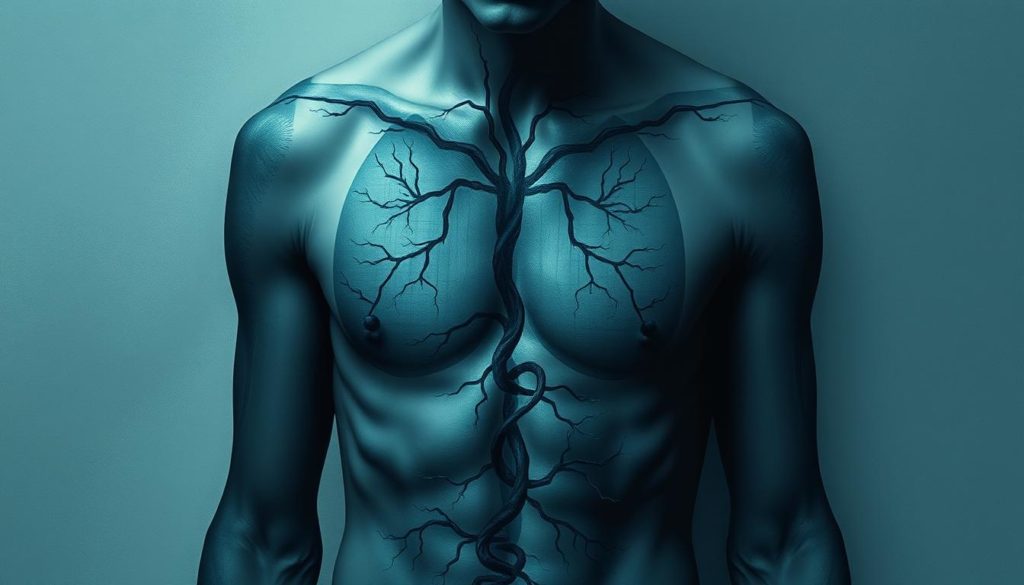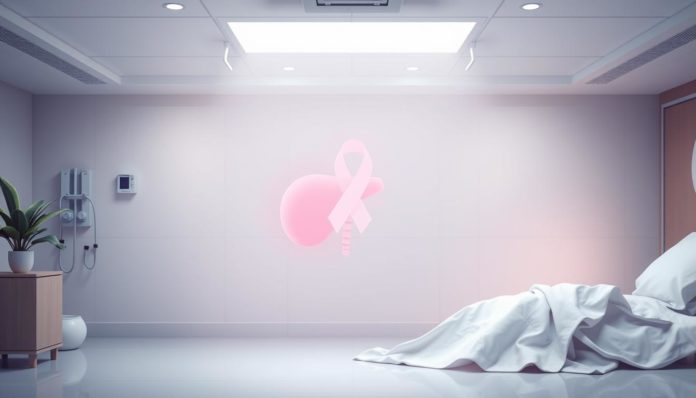Did you know up to 85% of men with prostate cancer treatment face erectile dysfunction (ED)? This shows how prostate cancer treatment greatly affects a man’s life. Managing ED becomes a key part of recovery, besides fighting cancer.
The journey to understand and treat ED starts with the right diagnosis. It leads to exploring prostate cancer treatment options. Options range from nerve-sparing surgeries and radiation therapy to more. Bear in mind, recovering erectile function takes time. Men may see improvements gradually, especially after nerve-sparing surgeries.
It’s vital to know how different treatments impact erectile function. We aim to guide you through ED and Prostate Cancer complexities. This article provides a detailed guide to navigate this landscape.
Understanding Erectile Dysfunction and Prostate Cancer
Looking at the connection between erectile dysfunction (ED) and prostate cancer is key for those being treated. Treatments for prostate cancer can affect erectile function, leading to Prostate Cancer-Induced Erectile Dysfunction. Knowing the causes and how often it happens can help in setting the right expectations and finding help.

What is Erectile Dysfunction?
Erectile dysfunction means not being able to get or keep an erection good enough for sex. This issue can be due to physical, mental, or lifestyle reasons. For men with prostate cancer, ED is often a side effect of their treatment. Understanding ED and Prostate Cancer is important in figuring out how to deal with it.
Why Prostate Cancer Causes ED
Prostate cancer and its treatments often cause erectile dysfunction. This is due to the nerves, muscles, and blood vessels needed for an erection. Surgeries like radical prostatectomies can harm tissues needed for erections. Cancer’s closeness to vital nerves and a patient’s age also play big roles in ED. Knowing these facts is crucial for managing Prostate Cancer-Induced Erectile Dysfunction well.
- Nerve damage: Surgery can harm nerves important for erections.
- Tissue removal: Treatment might damage or take out tissues needed for an erection.
- Blood vessel impact: Treatments can hurt blood flow needed for erections.
- Patient age: Older patients might find getting erections harder after treatment.
| Factor | Description |
|---|---|
| Nerve damage | Effects of surgery on key nerves for erectile function. |
| Tissue removal | Loss or harm of tissues vital for erections. |
| Blood vessel impact | Treatment can lead to less blood flow needed for erections. |
| Patient age | Older individuals may struggle more with erectile function after treatment. |
Erectile Dysfunction Prostate Cancer Treatment
Dealing with erectile dysfunction (ED) after prostate cancer treatment can be tough. There are many ways to help fix it. The best method depends on the patient and how they react to different treatments.
- Medications: Oral meds like sildenafil (Viagra) and tadalafil (Cialis) are often tried first for ED. They work well for some, but not everyone.
- Mechanical Devices: If pills don’t work, devices like vacuum erection devices and penile pumps might help. They assist in getting and keeping erections.
- Surgical Options: For tougher cases, penile implants are a long-term fix. They can be inflatable or bendable. This choice suits those who didn’t benefit from other treatments.
- Psychological Counseling: Talking with a counselor can help with the mental side of ED. This support is vital and can make other treatments work better.

Managing Prostate Cancer with ED needs plans made just for you. This might mean using both pills and devices. Learning and trying different options can help find the best way to deal with Prostate Cancer and ED.
Laser Prostatectomy and Its Impact on Erectile Function
When looking at treatments for prostate cancer, it’s crucial to know how Laser Prostatectomy Impacts ED. This surgery uses advanced Nerve-Sparing Techniques. Its goal is to keep erectile function intact by not harming the essential nerves for erections.
Nerve-Sparing Prostatectomy
Nerve-sparing techniques have greatly improved results in laser prostatectomy. They aim to save the neurovascular bundles that affect erectile function. Experts like Dr. Patrick Walsh have led the development of these methods. They are proving to reduce the Laser Prostatectomy Impact on ED. When nerve-sparing is done right, it can improve sexual health after surgery. This gives patients a higher quality of life after treatment.
Statistics on Recovery
The outcomes of Prostatectomy Recovery Statistics can differ a lot. They depend on the surgery type and the surgeon’s skill. Research shows about 40-60% of men might get back their erectile function within two years. Using cutting-edge Nerve-Sparing Techniques is key in these statistics. It shows the value of careful surgery and care after the operation.
| Recovery Duration | Percentage of Men Regaining Erectile Function |
|---|---|
| 6 months | 20-30% |
| 1 year | 30-50% |
| 2 years | 40-60% |
Radiation Therapy and ED: What You Need to Know
Understanding how radiation therapy for prostate cancer affects erectile dysfunction (ED) is important. Different radiation therapy types impact erectile function in various ways. Patients should be aware of the short-term and long-term expectations.
Types of Radiation Therapy
Two main radiation therapy types are used for treating prostate cancer: EBRT and brachytherapy. EBRT sends high-energy rays from outside, targeting the cancer. Brachytherapy involves placing radioactive seeds directly into the prostate. Techniques like IMRT are designed to protect surrounding tissues. This can help lower the risk of ED.
Short-term and Long-term Effects
The short-term and long-term effects of radiation therapy on ED can vary. Early on, men might see a decrease in erectile function due to nerve damage. Luckily, newer radiation methods have helped improve these outcomes. Over the long haul, outcomes can change. Some men might see improvements within 2-3 years post-treatment. However, about 15 years after treatment, the risk for ED can rise, leading to a noticeable drop in function.
Hormone Therapy: Benefits and Side Effects
Hormone therapy is used to treat prostate cancer by lowering testosterone levels. This slow down cancer cell growth. Prostate Cancer Hormone Treatment has improved disease management a lot. But, it’s important to know about its side effects, like erectile dysfunction (ED).
The Hormone Therapy ED Side Effects include less sexual desire and trouble keeping an erection. Despite these issues, there’s a silver lining. Some side effects may go away after therapy ends. Yet, recovery varies from person to person.
If you’re thinking about Prostate Cancer Hormone Treatment, talk to your doctor. Discussing sexual side effects early can greatly help. It can improve your life quality.
| Benefit | Side Effect |
|---|---|
| Slows Cancer Progression | Reduced Libido |
| Potential Reversal Post-Therapy | Erectile Dysfunction |
| Improves Survival Rates | Mood Swings |
Knowing the pros and cons of Hormone Therapy ED Side Effects is key. It helps men make better treatment choices. This ensures a well-rounded approach to health and wellness.
Medications for Managing Erectile Dysfunction Post-Treatment
After prostate cancer treatment, it’s key to manage erectile dysfunction well. This helps maintain quality of life. Many erectile dysfunction post-treatment medications are made to bring back erectile function and improve sexual health.
There are oral ED medications and injectable ED therapies. They both work by increasing blood flow to the penis. This helps in getting an erection. Let’s look into these options more.
Oral Medications
Oral ED medications include PDE-5 inhibitors like Viagra (sildenafil), Cialis (tadalafil), and Levitra (vardenafil). These have been effective in bringing back erectile function after prostate cancer treatment. They are very helpful after a nerve-sparing prostatectomy because they increase blood flow to the penis.
These medications should be taken about an hour before sexual activity. They provide a easy and non-invasive way for many patients. While some may experience headaches and digestive issues, the benefits usually outweigh these small problems for most people.
Injectable Medications
For those who don’t do well with oral medications, injectable ED therapies are a solid choice. Medications like alprostadil are injected directly into the penis. They cause strong erections by widening blood vessels and boosting blood flow.
Even though the idea of injections might seem scary, their fast action and high success rate make them preferred by many. Remember, it’s important to get proper training to avoid any issues.
| Medication Type | Examples | Administration | Success Rate |
|---|---|---|---|
| Oral ED Medications | Viagra, Cialis, Levitra | Oral | 70-80% |
| Injectable ED Therapies | Alprostadil | Injection | 85-90% |
Mechanical Devices to Aid in ED Recovery
Many men getting better from prostate cancer find Mechanical ED Devices crucial. They help by boosting blood flow in the penis. This flow is necessary for good erections.
One key example is Vacuum Constriction Devices for ED. They use a vacuum to pull blood into the penis. Then, a ring at the base keeps the blood there for erections.
Below is a comparison of different Erectile Recovery Aids:
| Device Type | Mechanism | Success Rate | Benefits |
|---|---|---|---|
| Vacuum Constriction Devices for ED | Vacuum-induced blood flow | High | Non-invasive, immediate results |
| Penile Implants | Surgical insertion | Very High | Long-term solution |
| Oral Medications | Increase blood flow via vasodilation | Moderate | Easy to use |
Erectile Recovery Aids are very important. They have lots of benefits for men dealing with ED after treatment. Choose the right Mechanical ED Device with a doctor’s help for the best recovery.
Surgical Options for Long-term ED Solutions
Penile implants are a common choice for long-lasting ED solutions. Though the surgery is detailed, the benefits are significant. People often experience a comeback in sexual function and high satisfaction rates.
Penile Implants
Three-piece inflatable penile implants offer a practical approach to ED. They allow a man to control erections. This significantly helps with satisfaction after surgery. Despite the complexity, their predictability and reliability attract many.
Success Rates and Patient Satisfaction
The success of penile implants is impressive, often surpassing 90%. Post-surgery, many men notice a boost in their quality of life and self-esteem. Almost all are happy with their sexual function after getting an implant.
The Role of Psychological Therapy in Managing ED
Managing erectile dysfunction (ED) after prostate cancer goes beyond just physical treatments. It’s pivotal to include Psychological Therapy for Erectile Dysfunction in the healing process. This addresses the emotional and mental health issues tied to this condition. Through ED Counseling, individuals and their partners can tackle relational issues and fears. These issues often block a happy sexual life.
It’s key to understand how closely mental health and ED recovery are linked. Psychological therapy offers strategies to deal with stress, sadness, and the emotional toll of prostate cancer treatments. By focusing on mental well-being during ED recovery, patients get a holistic healing experience. This means getting better both physically and emotionally.
ED Counseling helps couples regain their closeness and work through sexual healing together. In therapy, there’s a safe place to talk freely, which leads to better understanding and support. This team effort makes sure both partners move forward together in their healing.
Healthcare providers often stress the value of Psychological Therapy for Erectile Dysfunction as part of a complete care approach. This all-around support helps tackle mental blocks. Doing so is a big step towards a satisfying and balanced life after treatment.
In conclusion, it’s crucial to see mental health as a key part of ED recovery. Counseling and therapy turn overcoming ED into a journey of emotional healing and stronger bonds. This shows the importance of a full, effective approach to managing erectile dysfunction.
Integrative and Holistic Approaches to ED and Prostate Cancer Management
Exploring Integrative Therapies for ED and Prostate Cancer can change lives. These therapies offer everything from diet changes to physical therapy. They also include mind-body practices. Their goal is to manage symptoms and boost overall health.
Integrative therapies complement traditional treatments. They make ED and prostate cancer treatment more complete.
Holistic Solutions for ED and Prostate Cancer often begin with what you eat. A balanced diet with lots of fruits, veggies, lean proteins, and healthy fats helps. It strengthens the immune system and boosts your energy. Adding exercise is key, too. It improves heart health and reduces stress and anxiety. These issues often come with chronic conditions and can make ED worse.
Mind-body practices like yoga, meditation, and acupuncture add extra support. They help lower stress, clear your mind, and improve emotional health. When used with other treatments for ED and Prostate Cancer, they help men deal better with their condition. They also make traditional medical treatments work better. These holistic approaches aim to restore balance and give men control over their health.
FAQ
What is Erectile Dysfunction?
Erectile Dysfunction (ED) makes it hard to get or keep an erection for sex. It happens due to issues with nerves, muscles, or blood flow.
Why does Prostate Cancer cause ED?
Prostate cancer treatments can harm erection tissues. How close the cancer is to nerves and the age of the patient also play a role in ED.
Are there specific treatments for managing ED and Prostate Cancer?
Yes, treating ED after prostate cancer needs a combo of methods. This includes meds, devices, surgery, and counseling, depending on what the patient needs.
What is a Nerve-Sparing Prostatectomy?
This surgery tries to save the erection nerves. Doing so helps a lot in getting back erectile function after the operation.
What are the recovery statistics for erectile function after prostatectomy?
How well men recover varies. If the surgery was nerve-sparing, 40-60% can expect their erectile function to return within two years.
What types of radiation therapy are available for prostate cancer?
Types include external beam radiation and brachytherapy. Advanced forms like IMRT are better at sparing nerves, lowering ED risks.
What are the short-term and long-term effects of radiation therapy on erectile function?
The short-term effect is usually a drop in erectile function. Long-term, some men face permanent ED. But, newer methods offer better chances of recovery in 2-3 years.
What are the side effects of hormone therapy for prostate cancer?
This therapy reduces testosterone, affecting desire and erectile function. But, these effects may reverse once treatment ends, though it varies by person.
How do oral medications help in managing ED post-treatment?
PDE-5 inhibitors boost blood flow to the penis, helping erection. They’re often the first step for ED after nerve-saving operations.
Can injectable medications be used for ED if oral medications fail?
Yes, when pills don’t work, injections into the penis can. They improve blood flow, helping with erections.
What are mechanical devices for ED recovery?
Devices like vacuum pumps aid erections by boosting blood flow. They come with a ring to keep the erection, and many men find success with them after treatment.
What surgical options are available for long-term ED solutions?
For a lasting ED fix, inflatable implants are an option. They have high success and make many men happy with the outcome.
How does psychological therapy contribute to ED management?
It looks at ED’s emotional side. Therapy helps with relationship issues and mental blocks. It can greatly enhance life and help with sexual recovery.
What integrative and holistic approaches are recommended for managing ED and prostate cancer?
Adding diets, physical therapy, and mind exercises supports overall well-being. These natural ways aim to boost life quality and tackle ED from cancer treatment.


